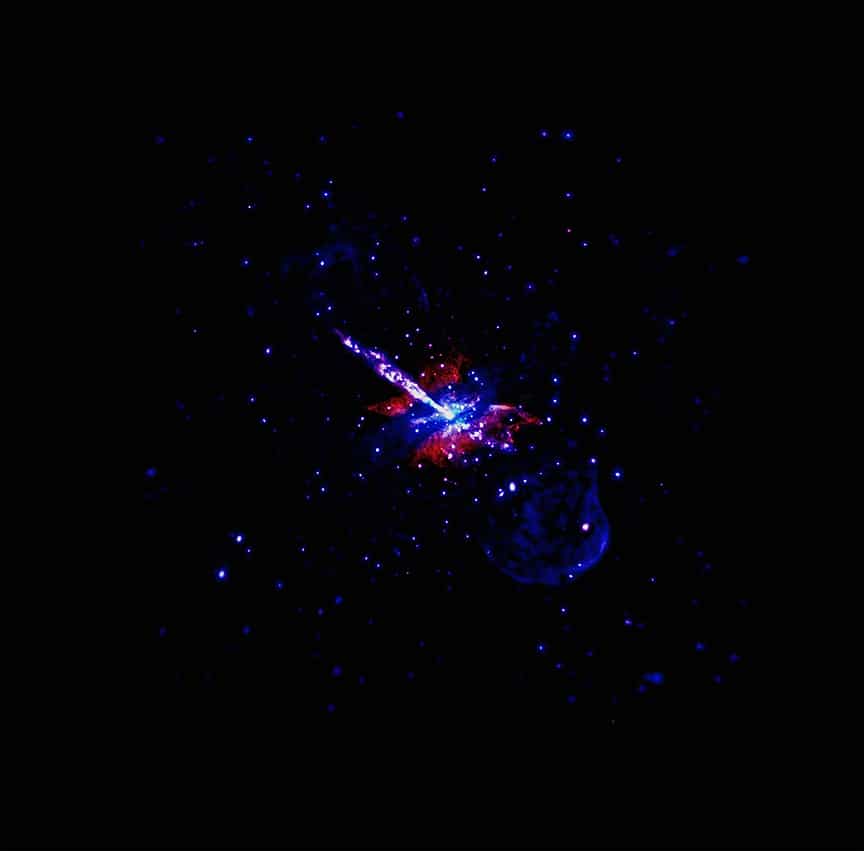In this stunning composite image, co-captured by Chandra, we have selected this image to honor the 25th anniversary of Chandra, which has played a pivotal role in X-ray astronomy since its launch in 1999.
Centaurus A is an elliptical lens galaxy about 300,000 x 450,000 light-years across, or about 3 to 4.5 times the diameter of the Milky Way. From Earth, you can only see this galaxy, located in the southern hemisphere, in the constellation Centaurus. The galaxy’s core contains a supermassive black hole with a mass of 55 million solar masses, which shoots out two giant jets of high-energy particles.

In the center of the image we see this central black hole as a bright white dot. From this center, the jet hurtling toward the upper left can be clearly identified as a purple/white fountain. A transparent blue cloud has formed around the entire galaxy, which can be seen best at the lower right of the image. These are the remains of the jets. Both the jets and the cloud have been extensively studied and imaged by Chandra.
Chandra X-ray Observatory
The Chandra X-ray Observatory satellite, which was placed into an elliptical Earth orbit by the Space Shuttle Columbia on July 23, 1999, is a NASA program. Great ObservatoriesThis space telescope program also includes James Webb and Hubble. While Chandra excels at X-ray imaging, other telescopes are interested in observing other parts of the electromagnetic spectrum in order to achieve the most complete picture possible.
Over the past 25 years, Chandra’s X-ray imaging has made groundbreaking observations of extremely active processes in the universe, such as neutron stars, black holes, and supernova remnants. Because high-energy radiation from distant objects is deflected, scattered, and almost completely blocked by our atmosphere and the Van Allen belts, there are no comparable ground-based observing options. As a space telescope, Chandra is positioned in a unique elliptical orbit, ranging from 16,000 to 133,000 kilometers above Earth. This allows the observing satellite to make observations during 85 percent of its 64-hour orbit, as long as it is above the Van Allen belts.
Various images: Chandra’s added value
The image below is the same image, but now from Chandra only. This underscores Chandra’s unique added value in making visible high-energy processes that cannot be observed with optical telescopes.

X-ray imaging in astronomy
The overall composition shows the amazing flow of particles escaping from the supermassive black hole, a phenomenon similar to that observed in other active galaxies such as Messier 87 (M87). Image of the central black hole of M87, taken by Event Horizon TelescopeIt provides a glimpse into the extremely energetic events that occur around supermassive black holes and highlights the value of X-ray observations.
Chandra’s contribution to astronomy remains undeniable, and this configuration of Centaurus A is a stunning example of the beauty and complexity of our universe.
Click here To download a high-resolution image of the composite image.
In recent decades, space telescopes and satellites have captured beautiful images of nebulae, galaxies, stellar nurseries, and planets. Every weekend, we take a great space image from the archives. Enjoy all the images? See them on this page.

“Lifelong entrepreneur. Total writer. Internet ninja. Analyst. Friendly music enthusiast.”











More Stories
Monster Jam Showdown Launch Trailer
The European Digital Twin Ocean prototype reveals many possibilities
Instagram now lets you add a song to your account